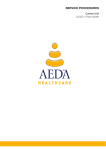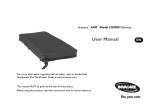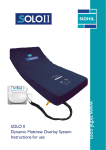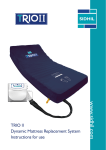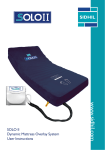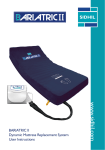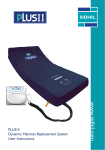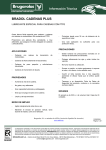Download Mattress 4 Pipe Replacement
Transcript
SERVICE PROCEDURES Mattress 4 Pipe Replacement 1 SERVICE PROCEDURES Contents 4 pipe Mattress Mattress3 Air Leak Test 4 Air Cell Replacement 6 Troubleshooting7 Safety9 Care & Cleaning 10 Definition of Symbols Used Caution: Warning of possible hazard to system, patient or staff. Warning of possible electrical hazard. Important operational information. 2 SERVICE PROCEDURES Unless the problem is known to be a fault with the Mattress Replacement, begin the service on the Control Unit. Should the system continue to lose pressure once all Control Unit service procedures have been successfully completed, follow these procedures to check the Mattress Replacement for potential damage and make the relevant repair. Always complete Basic System Checks before commencing any Mattress service procedure. 4 pipe Mattress It is recommended that any returned Mattress be thoroughly cleaned before commencing service (refer to Care and Cleaning) and that protective gloves and gown are worn throughout the procedure. Any fault or damage to the product that is not discussed in these Service Procedures is deemed a non serviceable issue. The faulty product must be returned to the Manufacturer for repair or replacement. Please note that this is a generic service manual which is applicable for several different models. Thus the products used in the pictures may differ from the product shown below. 3 SERVICE PROCEDURES Air Leak Test 4 pipe Mattress Testing for a leak in the Air Cells or Side Bolsters Insufficient system pressure will be identified by the visible and audible Alarm functions and flashing Pressure Setting LEDs. One of the Mattress Air Cells or Side Bolsters may be punctured or damage, causing air to leak from the system. Follow the steps below to determine if an Air Cell or Side Bolster is leaking. The following tools are required: • Control Unit • Plastic sheeting (or other protective material) 1 2 3 5 6 7 Ensure the Mattress has been correctly set up following the procedures outlined in the User Manual provided with the system. • Sand bags (or other weighted device) 4 Turn off the Control Unit. Disconnect the Mattress Handle and quickly connect the Transport Cap to seal air inside the Mattress (i.e. Transport Mode). Replace the Mattress Top Cover to protect the individual Air Cells from damage. Cover the Mattress with plastic sheeting or other protective material to protect the Top Cover from soil or damage during testing. Remove the Mattress Top Cover. Check all CPR Tag sealing connectors are pushed firmly on to the Mattress air pipes. Check each Air Cell and Side Bolster is firmly connected to each internal air pipe connector. Using sand bags or other soft weighted device, spread sufficient weight evenly along the surface of the Mattress to simulate a patient lying on the system. Do not exceed the maximum weight limit of the System. Connect the Control Unit and wait the prescribed time for complete Mattress inflation. When initial inflation is complete, the system automatically defaults to Alternating Mode. Switch to Static Mode and wait a further 10 minutes to ensure all cells are inflated to maximum pressure. Leave the weight on the Mattress for a minimum of one hour (in case of slow leak). 4 SERVICE PROCEDURES Air Leak Test 8 After one hour, remove the protective sheeting and remove the Mattress Top Cover. Manually feel each Air Cell to check inflation. Any partially inflated cell should be removed and replaced. Go to Air Cell Replacement procedure for next steps. 4 pipe Mattress 9 Manually feel both Side Bolsters to check inflation. If either Side Bolster is partially inflated, the system should be returned to the Manufacturer for further repair or replacement. 5 SERVICE PROCEDURES Air Cell Replacement 4 pipe Mattress Replacing a leaking Air Cell Having completed the Air Leak test detailed previously (steps 1 through 8), replace all suspected leaking or damaged Air Cell/s. No tools are required for this procedure. The following replacement parts are required: 9 Deflate the Mattress by pulling the CPR Tag and applying pressure on the Air Cells to release the air. • Air Cell/s Please note, on some mattress models, Air Cell connection may appear slightly different – white tubes connecting to a red nozzle on the base or bolster (as illustrated above). To disconnect, gently pull and twist the tube as described above. 12 Carefully remove the Air Cell by pulling it through the material positioning straps. 13 Unpack the replacement Air Cell and feed back through the material positioning straps in the same alignment as before. 10 11 Please note, Mattress Replacements have two press studs at each end of the cell. Please note, Mattress Replacements have two internal air pipes, one connected to the upper alternating cell and one to the lower static cell. Both air pipes need to be removed. 14 15 To disconnect a faulty Air Cell, detach the press stud (connecting the individual Air Cell to the Mattress base). Reconnect the Air Cell air pipe by pushing firmly until the pipe fully covers the connector. Reconnect the press stud fastening the cell to the base. For the Mattress Replacement, replace both air pipes and both press studs. Gently pull and twist the internal air pipe to disconnect it from the cell. Some strength may be required to free the air pipe from the connector. Repeat for all suspected leaking or damaged Air Cells. Repeat the Air Leak Test to ensure all Air Cells are maintaining maximum pressure and there are no leaks or loose air pipe connections. 6 SERVICE PROCEDURES Troubleshooting The following section outlines a list of common troubleshooting issues, together with recommended initial checks and subsequent Technical Service steps and procedures to follow if there is a suspected fault in the System. If a repair seems unmanageable, the issue falls outside the scope of serviceable repairs or the problem persists following the recommended service checks and repair procedures, please return the faulty System (Control Unit; Mattress; or both) to the Manufacturer. Problem Cause Initial Checks Control Unit does not operate; no display lights illuminate. The Control Unit may not be attached to a power source. 1. Check the Control Unit is connected to mains power outlet with the correct voltage. The power cord may be damaged. A fuse may need replacing. Control Unit The system may have an air leak. operational but The Air Filters may need cleaning red Alarm LED or replacing. illuminates (Mattress fails to reach or drops below accepted minimum level). Technical Service Procedure Control Unit Fuse Check and 2. Check the Control Unit is switched on. Switch Replacement off and disconnect the unit before restarting. Control Unit Printed Circuit Board Check 3. Check the Control Unit with a spare power and Replacement cord (in known working condition). 1. Check the Handle is securely attached to the Control Unit. Control Unit Air Filter Maintenance 2. Check the CPR Tag is intact, ensuring all sealing connectors are fully fitted to the Mattress air pipes. Control Unit Compressor Check and Replacement 3. Check all pipes along the inside of the Mattress – each should be firmly connected. 4. Check each Air Cell and/or Side Bolster is securely attached to the connecting air pipe. Mattress fails to inflate. 5. Check all cells, pipes and pipes for any air leakage. 6. Check air filter covers are secure and air filters are clean. The Control Unit is ‘grinding’ or making an unusual noise. The Synchronous Motor (timing motor) may be damaged. The Mattress is inflated but static head cells are still deflated. System may need more time to inflate – air pressure must build in alternating section before static head cells inflate. CPR Tag is not fully connected. Valves to static head cells may be damaged or cracked. Control Unit Synchronous Motor Replacement 1. Check system has had sufficient time for initial inflation (40 to 50 minutes). 2. Check the CPR Tag is intact, ensuring all sealing connectors are fully fitted to the Mattress air pipes. Return System to Manufacturer for further repairs or replacement. 3. Visually check the internal Mattress air pipes that run from the CPR Tag to the static head cells for splits, cracks or other damage. 7 SERVICE PROCEDURES Troubleshooting Problem Cause Initial Checks Technical Service Procedure The Mattress is not alternating. Static or Max Firm modes may be activated. 1. Switch the Control Unit off and disconnect the power before Synchronous Motor restarting. Ensure Alternating Mode is selected. Replacement Patient is sinking or “bottoming out” while lying flat on Mattress. The pressure may be set too low for the patient’s weight. 1. I ncrease Pressure Setting – an incremental increase is usually sufficient but wait 12 minutes (one full cycle) before checking. The system may be losing pressure. 2. P erform “bottoming out” test: a. With patient lying supine, fold back one side of the Mattress Top Cover just past sacral region (lower spine). Mattress Service Procedures b.Slide hand underneath the patient and feel for a deflated cell under the patient’s lower spine. Any inner static cell will remain inflated however your hand should easily slide between patient and base. c.If patient is adequately suspended, pressure setting can be lowered however this test should be repeated after approximately 20 minutes. 8 SAFETY Precautions General Safety Precautions Do not use this equipment in the presence of flammable anesthetics. Explosions could result. The air intakes for the Control Units are at the sides of the unit. To avoid the risk of blocking these intakes, it is recommended that the unit be mounted on the footboard of a bed frame. Should the bed not have a suitable footboard, it is recommended that the unit be placed on a solid surface such as a table, or on the floor. Protection Against Hazards Fluids Avoid spilling fluids on any part of the Control Unit. If spills do occur: • Disconnect the unit from the mains wall socket. • Clean fluids from the case. Ensure that there is no moisture in or near the power inlet, power switch and power plug before reconnecting the power supply. • Check the operation of controls and other components in the area of the spill. • Perform applicable checkout procedures. Liquids remaining on the electronic controls can cause corrosion that may cause the electronic components to fail. Component failures may cause the unit to operate erratically, possibly producing hazards to patient and staff. Disposal Dispose of the Air Filter, Air Cells, Foam inserts and/or Mattress Top Cover according to local procedures and regulations. At the end of useful life, dispose of waste according to the European Union Waste Electrical and Electronic Equipment (WEEE) Directive and in compliance with relevant local regulations. Power Cord The system should never be operated with a worn or damaged power cord. Should the power cord be found to be worn or damaged, replace immediately and dispose of the damaged cord. Interference Although this equipment conforms to the intent of the Directive IEC 60601-1-2 in relation to Electromagnetic Compatibility, all electrical equipment may produce interference. If interference is suspected, move equipment from sensitive devices or contact the Manufacturer. (IEC 60601-1-2. Medical Electrical Equipment – Part 1: General Requirements for Safety, Amendment No. 2. Collateral Standard: Electromagnetic Compatibility Requirements and Tests). 9 CARE & CLEANING Recommendations General Recommendations Follow the Manufacturer’s instructions as detailed below and in the applicable User Manual. Failure to do so may result in cross contamination or equipment damage. Do not use high temperature autoclave steam cleaning devices or phenolic based cleaning products. Use of either of these items could result in damage to equipment and/or loss of waterproof qualities of the Top Cover. To prevent cross contamination, the Manufacturer recommends that the system be cleaned and laundered between patients according to the instructions below. Always disconnect the Control Unit from mains power before cleaning. Do not spray disinfectant directly on to the unit, or immerse the unit in any type of liquid. Failure do so could result in equipment damage and / or electric shock. The System may be cleaned according to local protocols and regulations/procedures for blood borne pathogens provided the Manufacturer’s instructions are followed. Refer to the Top Cover wash tag for detailed cleaning instructions. Cleaning While System in Use The System should be cleaned every two weeks if in constant use. If the interior of the Mattress shows signs of fluid contamination, inspect the Top Cover for punctures or damage. Allow all parts to dry thoroughly before returning to use. 1 2 3 4 5 6 If the Top Cover is damaged it should be replaced before returning the system to use. Remove patient from the System. If necessary for inspection or cleaning, the Air Cells may be removed by carefully disconnecting the air pipes and unsnapping the cell. It is not recommended that Side Bolsters be removed for cleaning. Unplug the Control Unit from mains power. Remove the Top Cover. Using a well wrung out cloth dipped in warm soapy water, wipe the surface of the Top Cover. Rinse with plain water and allow to dry. Pull the CPR Tag and disconnect the Handle from the Control Unit to allow the Mattress to deflate completely. 7 8 Inspect the interior of the Mattress for any signs of fluid contamination. sing a well wrung out cloth dipped in warm soapy water, U wipe the Mattress base, cells and Side Bolsters (where applicable). Rinse with plain water and allow to dry. Using a well wrung out cloth dipped in warm soapy water, wipe the Control Unit, Handle and Air Pipes. Do not allow fluid to penetrate the Control Unit. 9 I f the Top Cover or Air Cells have become excessively soiled they may be laundered in a washing machine at up to 95°C using normal domestic washing powder. Do not add bleach to the wash cycle. Rinse well using plain water and dry thoroughly before use. Do not dry the Top Cover using the heat cycle or a dryer. Air dry or select a low of non-heat dry cycle. 10 CARE & CLEANING Recommendations Cleaning and Maintenance Between Patients Inspect all parts for damage and replace as necessary before returning to service. Do not return the Control Unit to service without replacing air filters. Do not allow fluid to penetrate the Control Unit. 1 2 3 4 The Mattress should be dismantled according to the instructions on the previous page. Launder the Top Cover and Air Cells as described on the previous page. Using warm soapy water (or sodium hypochlorite solution at 10,000ppm) and a well wrung cloth, clean the Mattress, Control Unit, Handle, Air Pipes and Side Bolsters (where applicable). Rinse with plain water and allow to dry thoroughly. Replace air filters (see the relevant Air Filter Maintenance procedure for details). 11 CONTACT INFORMATION Aeda Healthcare Limited 15th Floor 100 Queen’s Road Central Central Hong Kong Tel: + 852 6832 5199 Fax: + 852 6832 5373 Email: [email protected] http://www.aeda.com 12














